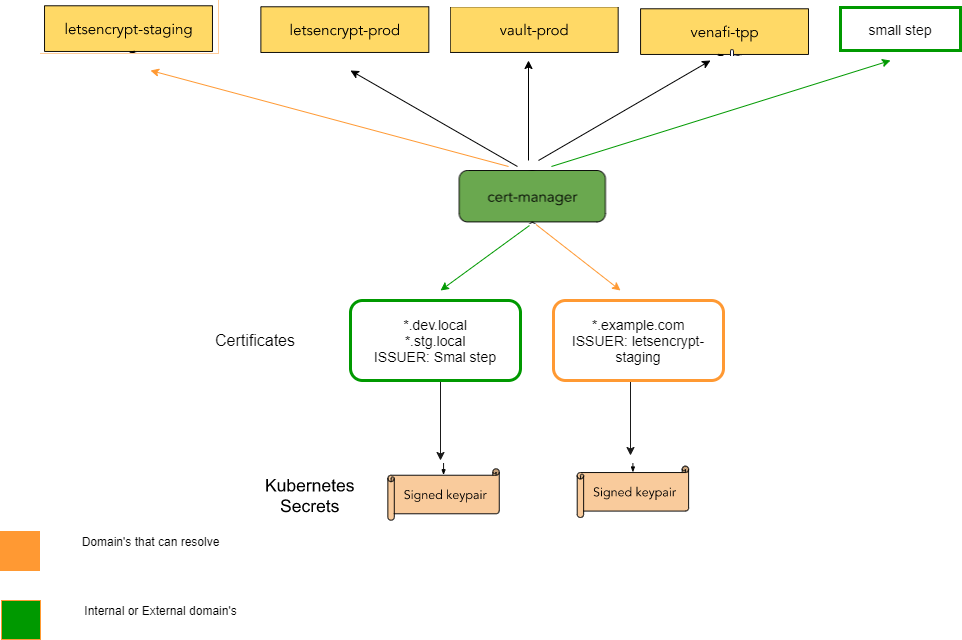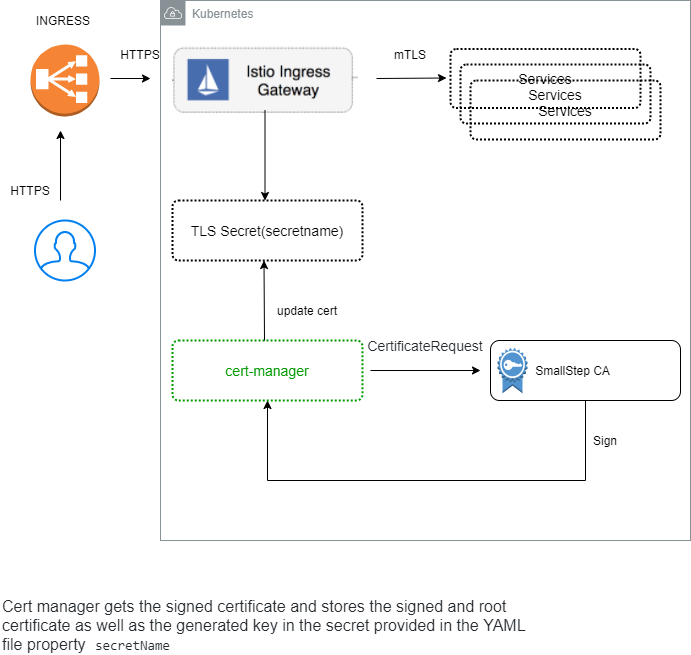SmallStep is a very powerful tool that can be used for many proposals and use cases.
In the following example, I will show how to setup a cert-manager with a smallstep, automatically create a certificate, and configure a mutual TLS ISTIO ingress gateway.
- Kubernetes cluster
- helm (3 and up)
- Kubectl
- istioctl
- ISTIO installed like:
istioctl install --set profile=demo
Clone repo, then run:
chmod +x setup.sh; ./setup.sh --name-space=istio-system
kubectl apply -f https://github.com/jetstack/cert-manager/releases/download/v1.2.0/cert-manager.yaml
- Verify pods created and running
kubectl -n cert-manager get pods --field-selector=status.phase=Running
Repository: https://github.com/smallstep/helm-charts
Repository: https://github.com/smallstep/step-issuer
We going to install the chart in the istio-system namespace because ISTIO will lookup for credentialName in the same namespace where the ingressgateway reside.
- Installing step certificates
helm repo add smallstep https://smallstep.github.io/helm-charts &&\
helm repo update && \
helm install step-certificates smallstep/step-certificates --namespace istio-system
- Output
1. Get the PKI and Provisioner secrets running these commands:
kubectl get -n istio-system -o jsonpath='{.data.password}' secret/step-certificates-ca-password | base64 --decode
kubectl get -n istio-system -o jsonpath='{.data.password}' secret/step-certificates-provisioner-password | base64 --decode
2. Get the CA URL and the root certificate fingerprint running this command:
kubectl -n istio-system logs job.batch/step-certificates
3. Delete the configuration job running this command:
kubectl -n istio-system delete job.batch/step-certificates
- Installing step issuer
kubectl apply -f https://raw.githubusercontent.com/smallstep/step-issuer/master/config/crd/bases/certmanager.step.sm_stepissuers.yaml
- Then we install the controller:
kubectl apply -f https://raw.githubusercontent.com/smallstep/step-issuer/master/config/samples/deployment.yaml
- Verify
kubectl get -n step-issuer-system all
- The provisioner kid
export KID=$(kubectl -n istio-system get -o jsonpath="{.data['ca\.json']}" configmaps/step-certificates-config | jq .authority.provisioners | grep "kid" | awk '{ print $2 }' | cut -f2 -d"\"")
- CA root certificate
export CABANDLE=$(kubectl -n istio-system get -o jsonpath="{.data['root_ca\.crt']}" configmaps/step-certificates-certs | base64 | tr -d \\n)
- The CA url
export URL=$(kubectl -n istio-system get -o jsonpath="{.data['defaults\.json']}" configmaps/step-certificates-config | grep -oP '(?<="ca-url": ")[^"]*')
kubectl apply -f - <<EOF
apiVersion: certmanager.step.sm/v1beta1
kind: StepIssuer
metadata:
name: step-issuer
namespace: istio-system
spec:
# The CA URL.
url: $URL
# The base64 encoded version of the CA root certificate in PEM format.
caBundle: $CABANDLE
# The provisioner name, kid, and a reference to the provisioner password secret.
provisioner:
name: admin
kid: $KID
passwordRef:
name: step-certificates-provisioner-password
key: password
EOF
Clone repo:
git clone https://github.com/Gershon-A/ISTIO-cert-manager-and-smallstep-ca
- Create namespace with ISTIO sidecar
kubectl.exe apply -f example/SmallStep-mutual/namespace.yaml
namespace/my-app created
- Create simple application deployment
kubectl.exe apply -f example/SmallStep-mutual/httpbin.yaml
serviceaccount/httpbin-m created
service/httpbin-m created
deployment.apps/httpbin-m created
- Create ISTIO gateway and virtual service
kubectl.exe apply -f example/SmallStep-mutual/httpbin-gateway.yaml
gateway.networking.istio.io/httpbin-m-mygateway created
virtualservice.networking.istio.io/httpbin-m created
- Create certificate:
kubectl.exe apply -f example/SmallStep-mutual/Certificate.yaml
certificate.cert-manager.io/httpbin-m-certificate created
- Check, that certificate successfully issued
kubectl get certificates.cert-manager.io -n istio-system
NAME READY SECRET AGE
httpbin-m-certificate True httpbin-m-secret 3m6s
kubectl describe certificates.cert-manager.io -n istio-system httpbin-m-certificate
..............
Events:
Type Reason Age From Message
---- ------ ---- ---- -------
Normal Issuing 3m27s cert-manager Issuing certificate as Secret does not exist
Normal Generated 3m27s cert-manager Stored new private key in temporary Secret resource "httpbin-m-certificate-959q9"
Normal Requested 3m27s cert-manager Created new CertificateRequest resource "httpbin-m-certificate-f8xv8"
Normal Issuing 3m26s cert-manager The certificate has been successfully issued
- Get CA
mkdir -p tmp && \
kubectl -n istio-system get secrets httpbin-m-secret -o jsonpath="{.data['ca\.crt']}" | \
base64 -d > tmp/ca-dev.local.pem && \
openssl x509 -in tmp/ca-dev.local.pem -text -noout
- Cert
mkdir -p tmp && \
kubectl -n istio-system get secrets httpbin-m-secret -o jsonpath="{.data['tls\.crt']}" | \
base64 -d > tmp/cert-dev.local.pem && \
openssl x509 -in tmp/cert-dev.local.pem -text -noout
- Key
mkdir -p tmp && \
kubectl -n istio-system get secrets httpbin-m-secret -o jsonpath="{.data['tls\.key']}" | \
base64 -d > tmp/key-dev.local.pem
- Determining the ingress IP and ports
export INGRESS_HOST=127.0.0.1
- Send SSL request
curl -v --resolve "httpbin-m.example.com:443:$INGRESS_HOST" --cert tmp/cert-dev.local.pem --key tmp/key-dev.local.pem --cacert tmp/ca-dev.local.pem "https://httpbin-m.example.com:443/status/418"
- Response:
* SSL connection using TLSv1.3 / TLS_AES_256_GCM_SHA384
* ALPN, server accepted to use h2
* Server certificate:
* subject: CN=*.example.com
* start date: Mar 5 12:39:34 2021 GMT
* expire date: Mar 6 12:40:34 2021 GMT
* subjectAltName: host "httpbin-m.example.com" matched cert's "*.example.com"
* issuer: CN=Step Certificates Intermediate CA
* SSL certificate verify ok.
* Using HTTP2, server supports multi-use
* Connection state changed (HTTP/2 confirmed)
* Copying HTTP/2 data in stream buffer to connection buffer after upgrade: len=0
* Using Stream ID: 1 (easy handle 0x71e320)
> GET /status/418 HTTP/2
> Host: httpbin-m.example.com
> user-agent: curl/7.71.1
> accept: */*
>
* TLSv1.3 (IN), TLS handshake, Newsession Ticket (4):
* TLSv1.3 (IN), TLS handshake, Newsession Ticket (4):
* old SSL session ID is stale, removing
* Connection state changed (MAX_CONCURRENT_STREAMS == 2147483647)!
< HTTP/2 418
< server: istio-envoy
< date: Fri, 05 Mar 2021 13:06:52 GMT
< x-more-info: http://tools.ietf.org/html/rfc2324
< access-control-allow-origin: *
< access-control-allow-credentials: true
< content-length: 135
< x-envoy-upstream-service-time: 38
<
-=[ teapot ]=-
_...._
.' _ _ `.
| ."` ^ `". _,
\_;`"---"`|//
| ;/
\_ _/
`"""`
ETH: 0x1Fa418c70C5f14b21D00c242Bf369A875F129d12

